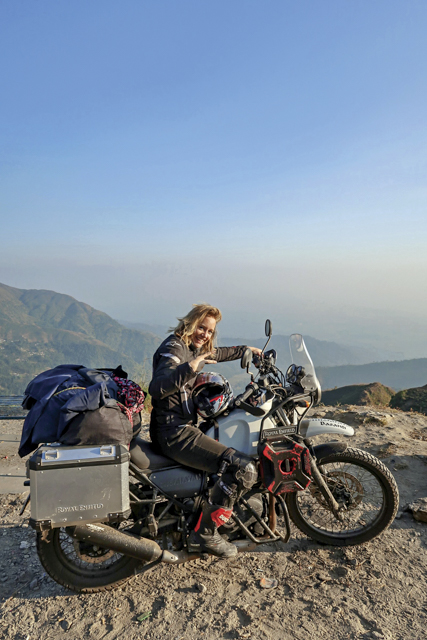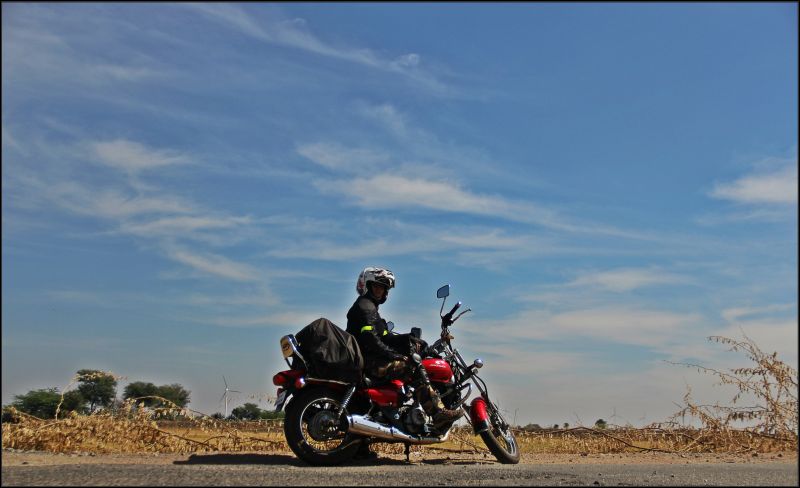Aravind KP talks to us about his most defining moment of Dakar 2019 and how he faced it to represent India at the finish-line [Read more…] about Interview – Aravind K P – ‘This year I focused on consistency and on getting through all the stages’
Interviews
Interview-Noraly Schoenmaker-Dutch Damsel on a Mission
 A woman sells all her possessions to go on the trip of a lifetime, starting from our country. We caught up with Noraly Schoenmaker via e-mail as she munched miles towards her destination [Read more…] about Interview-Noraly Schoenmaker-Dutch Damsel on a Mission
A woman sells all her possessions to go on the trip of a lifetime, starting from our country. We caught up with Noraly Schoenmaker via e-mail as she munched miles towards her destination [Read more…] about Interview-Noraly Schoenmaker-Dutch Damsel on a Mission
Lone Gal Traveller

Esha Gupta from Bangalore explores the nation solo on a motorcycle
Interview with Shreya Sundar Iyer of TVS Racing: Woman of Substance

At 24, Shreya Sundar Iyer has already entered the Indian motorsport history books by becoming the first ever woman rider for TVS Racing. On the cusp of her first ever competitive event at the Indian National Rally Championship, asst ed Aninda Sardar caught up with the de-stressed damsel [Read more…] about Interview with Shreya Sundar Iyer of TVS Racing: Woman of Substance
Eloquent Rider
 No impediments when an enthusiastic motorcycle rider, who is a speech therapist by profession, takes up the pen to chronicle his long and adventurous journeys. Bike India talks to Dr Ajit Harisinghani, whose second travelogue is to be published soon.
No impediments when an enthusiastic motorcycle rider, who is a speech therapist by profession, takes up the pen to chronicle his long and adventurous journeys. Bike India talks to Dr Ajit Harisinghani, whose second travelogue is to be published soon.
A sense of calm and serenity overpowers you as you enter Dr Ajit Harisinghani’s speech foundation. This Pune-based doctor trains young professionals and stroke patients to recover from speech impediments. A speech therapist by profession and a grey-haired free-spirited motorcyclist at heart, Dr Ajit offers us a close-up view of his trip to Ladakh. He also tells us about his next book, which speaks about his visit to Bhutan and several other experiences.
BI: Before being a motorcyclist, you are a speech therapist. At a time when the profession was unheard of and a comfortable Central government job was the most sought-after prospect, you opted for speech therapy. Why?
AH: Back in the 1960s the only options were medicine, engineering or graduation. I missed the medical seat by 12 marks and had to settle for a degree in chemistry and zoology. Forget others, I myself didn’t know about speech therapy until I stumbled upon it. One day I had missed college to watch the newly released film, ‘Shagird’, umm, I think it had Joy Mukherjee and Saira Banu in lead roles. I had some time before the show began and so I just sauntered into the Nair Hospital next door. I read a notice that said, ‘Speech Therapy admissions closing today’. Spurred on by an urge to be in a medical setting I enrolled myself for the course and eventually developed a deep liking for it. I enjoy my job immensely now.
BI: A large number of people ride to Ladakh, a few blog about it and even fewer write books about it. So what inspired you to write a book about such a deeply personal experience?
AH: Writing a book is like painting a blank canvas. As you experience the journey you start painting the canvas with colourful brush strokes. And while doing this I have to keep the reader in mind. As you rightly said, a lot of people ride to Ladakh. Who really wants to listen to an old man riding from one place to another? Who cares about how much fuel I used and where I stopped for lunch? And that’s the reader’s perspective. To make the book enjoyable and readable I have to connect with the reader and make him/her feel the journey. So connecting with a younger audience is the challenge and that’s what got me hooked.
BI: You have been riding for over 35 years now and you must have suffered a major breakdown somewhere some time. Tell us about it.
AH: I suffered one, actually two major breakdowns. One I have mentioned in the book. It happened on the way to Leh from Manali. That one didn’t exactly leave me helpless, but it was quite bad. I realised it was only a loose contact in the ignition. I had other keys in the keyring which kept the ignition key from connecting. The other major breakdown occurred on my trip to Bhutan. I was near the Krishnanagar area in Nadia district of West Bengal. The contacts were loose, the wiring was burnt and I had no spares. And believe it or not no one rides a Bullet in West Bengal. So I had to wait for an entire day until I could get some spares and get the bike going again. Also in Bhutan there is just one Bullet service centre for the Indian Army. Apart from these two incidents the Royal Enfield has proved to be a very reliable companion.
BI: Other than the Royal Enfield which other bikes have you ridden and in which other countries?
AH: I had two Yezdis in Bombay when I was a student. That bike didn’t really suit me and I had a lot of problems with it. A little rain and it would stall, the carburettor would get flooded easily. And then in the US my room-mate had a Norton 750 Commando, which I used to ride once in a while. Finally, I chanced upon the Bullet in 1983. I bought it for Rs 17,000. Since then I have owned three Standard 350 Bullets, including the current one that I bought in 1995. And it is still in the same condition as it was when I got it from the dealer. Apart from the fabricated panniers it hasn’t undergone any modification.
BI: Your next book is about your trip to Bhutan and other adventures. Tell us about it.
AH: My second book starts with an encounter with one of my patients, the mass obsession with happiness and things like that. Then I see the King of Bhutan on the television and things generally flow in that direction. Also there are a few other incidents which now seem very hilarious. Back then, however, it was a totally different picture. Prison incidents, small deals, hitch-hiking, etc. It is all a colourful and funny picture now. After the response my first book elicited, there is a pressure to do better in the second book. I want to ward off that pressure and take things slowly. I am going to relax and let the ideas flow to me and eventually compile them.
BI: By the way, did you find out what the problem was with your bike in the chapter ‘Machinophilia’?
AH: As a matter of fact, I did. The carburettor was flooded! But that incident did serve as a literary trick for the book.

